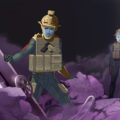Shin Megami Tensei IV: Apocalypse– A New Adventure in a Familiar Twisted Tokyo

I wrote about Shin Megami Tensei IV: Apocalypse no less than three times in great detail for our Quarantine Control column. A review shouldn’t come as a surprise.
After the success of the original Shin Megami Tensei: IV and Atlus’s track record of creating spin-offs, remakes, and sequels Apocalypse was bound to be developed. This game is not quite a full sequel, remake, or spin-off and lands somewhere between these three categories. In Japan it was released three years after SMTIV, two months after Tokyo Mirage Sessions #FE, and eight months before Persona 5. Even with the delay in releases in North America, these three games still came out within months of each other. It was a great time to be a Megaten fan, but it was easy for one of these titles to get lost in the shuffle. For me that game would be Apocalypse.
I didn’t get around to playing SMTIV: Apocalypse until 2020. Part of me was worried that I would sour on aspects of the game like I did with Shin Megami Tensei: Strange Journey Redux. Another part of me was tired of Atlus’s bad habit of retconning new characters into existing stories. Thankfully, by making Apocalypse both a partial sequel and side story, Atlus avoided the issue entirely. From start to finish I thoroughly enjoyed my time in this version of post-apocalyptic Tokyo.

Flynn has been hailed as the liberator of Tokyo and is working hard to stop both Merkabah and Lucifier from destroying the city. As he, Isabeu, and the Hunter’s Association prepare against the angels and demons, life goes on for two cadets. 15-year-old Nanashi and his best friend Asahi are preparing to become hunters and go on a mission to gather food with their seniors, Nikkari and Manabu. They are suddenly attacked by Adramelech, a powerful demon serving under Lucifier. The demon kills their seniors and Nanashi effortlessly. As Nanashi makes his way to the afterlife, he’s stopped by a demon named Dagda. The former deity offers the young cadet a chance at a second life by giving him the opportunity to become a “Godslayer.” Nanashi accepts and is instantly revived. He fights off Adramelech and saves Asahi’s life.
The two teens officially join the Hunter’s Association with the hopes of helping Flynn and Isabeu save Tokyo. Asahi becomes frustrated when they’re only given fetch quests to complete. As she complains, they’re approached by an old man who asks for a meeting in private. There he reveals himself to be Odin and tells them about an ark under Tokyo. Sealed inside is a powerful being that can help Flynn defeat Merkabah and Lucifier. He offers them a quest to break the seal. Odin can’t set the being free because the seal can only be broken by humans. Without a second thought the young hunters accept the quest.

They defeat the demon guarding the ark. He begs them not to undo the seal because the deity trapped inside is too dangerous to set free. The seal is undone whether the player has Nanashi break it or backs out only for Dagda to forcibly have Nanashi break it. The freed deity reveals himself as Krishna, leader of the Divine Powers. They are a faction made up of polytheistic gods who wish to save humanity and remake the universe by overthrowing Lucifier, Merkabah, and ultimately God himself. Suddenly, the conflict in Tokyo expands as humanity has to deal with angels, demons, and a rouge faction of deities.
SMTIV: Apocalypse’s story can take several paths depending on the player’s choices. It can feel like a continuation of SMTIV, a Persona game complete with the power of friendship, or a much darker story similar to Strange Journey. Apocalypse is essentially SMTIV’s neutral story path on steroids. No matter what path is taken this game’s endings are a vast improvement over the xenophobic ending of the original game. It feels like Atlus took criticism of the original ending into consideration. The only disappointment I had with the story was the inability to join the Divine Powers. It would have been fascinating to have the option to follow their worldview and take part in bringing that reality to fruition.
Apocalypse heavily reuses assets from SMTIV. It’s to be expected because the game takes place in many of the same locations. There are new areas to explore, but none of them are a departure from the previous game, save for the final dungeon and some DLC areas. 3D models and photorealistic art are used for a handful of bosses which can be jarring at times. In terms of design, if you enjoyed Masayuki Doi’s character designs from IV, again expect more of the same here. That goes double for Kazuma Kaneko’s demon designs– though I can’t say I’m a fan of Odin’s redesign. On the plus side, I absolutely loved the designs of the rest of the Divine Powers, Dagda and the second form of the final boss.

Ryota Kozuka reprises his role as the music composer. There aren’t a lot of new tracks for Apocalypse as much of the music from the original game is recycled. The majority of the new tracks used range from excellent to forgettable. I admit it took some time for the songs to grow on me, especially the battle themes. The regular boss battle theme is similar to music found in IV with its heavy electric guitar use. The special boss fights are their own unique treats. The chaotic energy is tense and borderline dissonant at times, but it’s fitting for the game. This soundtrack doesn’t surpass anything found in its predecessor, but it is certainly on par.
It is clear that the developers took a lot criticism from SMTIV to heart and strove to make big improvements in this follow up title. The quality of life changes made to the gameplay are immensely satisfying.
The first big change is the addition of magic affinities. These affinities range in strength from +9 all the way down to -9. Just like in other SMT games with the right fusion any demon can learn just about any ability, even ones that are the complete opposite of their own element. For example, having Jack Frost learn fire spells. In Apocalypse, a Jack Frost could learn that fire spell, but its affinity would be in the negatives and the power of the spell would be much weaker. In contrast any ice spell the Jack Frost learns would have positive affinities making it more powerful. This system makes you think harder about demon abilities and which spells are worth your time.
Other changes include adjustments the smirk system, revamped Hama and Mudo spells, and the addition of an assist gauge. The smirk system largely works the same way as in SMTIV. If you successfully pinpoint an enemy’s weakness, your character smirks giving you a guaranteed critical hit during your next turn. However, in Apocalypse smirks are also tied to Hama and Mudo. They are only instant kill spells when a character is smirking. Otherwise they count as regular magic. This game also introduces the ability to remove smirks via the Magaon ability or to smirk at any time with Smile Charge.

The assist gauge functions much like the All-Out Attacks in the newer Persona games where all of your partners will attack an enemy for unblockable damage. This gauge fills up with every player turn taken in battle. Which means the assist can be activated during a regular random battle or during a boss fight. This feature is great for turning the tables when a tough enemy is bench pressing your entire party, but is annoying when trying to recruit a demon.
Other parts of the gameplay received minor adjustments. The pierce ability system is back, but here it also ignores repel and reflect. Demons recruitment is slightly more forgiving. The game gives you complete control over deciding which spells fused demons inherit and the order of spells can be rearranged at any time. The partner AI has been reworked so they’re actually helpful in battle and partners are selectable at will. And yes, the accursed overworld map was fixed. It includes both location names and objective markers– how I ever put up with the original map from SMTIV is beyond me.
My biggest criticism of Apocalypse is how much easier the game is compared to SMTIV or Strange Journey Redux. The possibility of being completely wrecked in random battles or boss fights is still there, but I didn’t find the game challenging until the final two bosses. I can’t say if this is because I’m use to the odds and ends of the SMT battle system or if the game is actually easier. I breezed through all of the dungeons (excluding Twisted Tokyo and DLC areas) in 87 hours. I managed to reach level 117 before the final fight (after breaking the level cap with free DLC). I can only speak for normal mode as I didn’t try the game on harder difficulties. The only roadblocks I encountered were related to obtaining money to fuse demons or to buy better armor. I did cave in and buy the DLC which makes obtaining macca much easier.

While we’re on the topic of DLC, another disappointment is how optional bosses and quests are locked away behind paid and free DLC. Options such as obtaining more macca or exp are one thing, but entire playable sections are another. It saddens me to know that once Nintendo stops supporting the eShop on the 3DS entire sections of Apocalypse will just disappear. Paid DLC may have been great for Atlus’ bottom line, but it’s not great for consumers or video game preservationists.
Even with its flaws, Shin Megami Tensei IV: Apocalypse is an amazing side story and soft sequel to Shin Megami Tensei IV. This story can be played without ever picking up the original game, but even with in-game notes a lot of context and nostalgia are lost. I couldn’t imagine playing Apocalypse without playing IV first. Unfortunately, physical editions of the game are out of print and not easy to find. Buying it from the eShop is the most affordable way to experience this gem. This game is an amazing JRPG that’s definitely deserving of your time.





